Effects of Multi-Pass Turning on Stress Corrosion Cracking of AISI 304 Austenitic Stainless Steel
Abstract
:1. Introduction
2. Material and Method
2.1. Procedures
2.2. Material
2.3. Specimen Preparation
2.4. Examinations of Roughness, Residual Stress, and Micro-Hardness
2.5. SCC Tests and Micro-Crack Measurements
2.6. Analysis of Variance
3. Results
3.1. Roughness
3.2. Residual Stress
3.3. Micro-Hardness
3.4. Micro-Crack
4. Discussion
4.1. Machining-Induced Roughness
4.2. Effect of Residual Stress
4.3. Micro-Hardness Analysis
4.4. Correlation between Surface Properties and SCC in Multi-Pass Turning
5. Conclusions
Author Contributions
Funding
Data Availability Statement
Conflicts of Interest
References
- Pan, Y.; Song, L.; Liu, Z.; Hu, J.; Li, X. Effect of hydrogen charging on SCC of 2205 duplex stainless steel with varying microstructures in simulated deep-sea environment. Corros. Sci. 2022, 196, 110026. [Google Scholar] [CrossRef]
- Bajares, R.A.; Di, M.L. Study of the Corrosion Rate in the Couple of Steels ASTM A-36 and AISI/SAE 304 in a Water-coke of Petroleum System. Proc. Mater. Sci. 2015, 8, 702–711. [Google Scholar] [CrossRef] [Green Version]
- Was, G.S.; Ukai, S. Austenitic Stainless Steels. In Structural Alloys for Nuclear Energy Applications; Elsevier: Amsterdam, The Netherlands, 2019; pp. 293–347. [Google Scholar] [CrossRef]
- De Bellefon, G.M.; Van Duysen, J.C. Tailoring plasticity of austenitic stainless steels for nuclear applications: Review of mechanisms controlling plasticity of austenitic steels below 400 °C. J. Nucl. Mater. 2016, 475, 168–191. [Google Scholar] [CrossRef] [Green Version]
- Kumar, A.; Sharma, R.; Kumar, S.; Verma, P. A review on machining performance of AISI 304 steel. Mater. Today Proc. 2022, 56, 2945–2951. [Google Scholar] [CrossRef]
- Fajobi, M.A.; Loto, R.T.; Oluwole, O.O. Austenitic 316L Stainless Steel; Corrosion and Organic Inhibitor: A Review. Key Eng. Mater. 2021, 886, 126–132. [Google Scholar] [CrossRef]
- Andrea, L.M.; James, W.M.; Zhirong, L.; Alistair, S.; Jose, A.R.; Dragos, A.A.; Mark, C.H.; Adam, T.C. Surface integrity in metal machining-Part II: Functional performance. Int. J. Mach. Tool Manuf. 2021, 164, 103718. [Google Scholar] [CrossRef]
- Wisley, F.S.; Julius, S.; Leonardo, R.R.D.S.; Álisson, R.M.; Jawahir, I.S. A review of surface integrity in machining of hardened steels. J. Manuf. Process. 2020, 58, 136–162. [Google Scholar] [CrossRef]
- Yue, C.; Gao, H.; Liu, X.; Liang, S.Y. Part functionality alterations induced by changes of surface integrity in metal milling process: A review. Appl. Sci. 2018, 8, 2550. [Google Scholar] [CrossRef] [Green Version]
- Kumar, C.S.; Patel, S.K. Application of surface modification techniques during hard turning: Present work and future prospects. Int. J. Refract. Met. Hard Mater. 2018, 76, 112–127. [Google Scholar] [CrossRef]
- Selvam, M.D.; Senthil, P. Investigation on the effect of turning operation on surface roughness of hardened C45 carbon steel. Aust. J. Mech. Eng. 2016, 14, 131–137. [Google Scholar] [CrossRef]
- Saini, S.; Ahuja, I.S.; Sharma, V.S. Residual stresses, surface roughen-ss, and tool wear in hard turning: A comprehensive review. Mater. Manuf. Process. 2012, 27, 583–598. [Google Scholar] [CrossRef]
- Yan, L.; Yang, W.; Jin, H.; Wang, Z. Analytical modelling of microstructure changes in the machining of 304 stainless steel. Int. J. Adv. Des. Manuf. Technol. 2012, 58, 45–55. [Google Scholar] [CrossRef]
- Liu, G.; Huang, C.; Zhao, B.; Wang, W.; Sun, S. Effect of machined surface integrity on fatigue performance of metal workpiece: A review. Chin. J. Mech. Eng. 2021, 34, 118. [Google Scholar] [CrossRef]
- Chung, Y.H.; Chen, T.C.; Lee, H.B.; Tsay, L.W. Effect of Micro-Shot Peening on the Fatigue Performance of AISI 304 Stainless Steel. Metals 2021, 11, 1408. [Google Scholar] [CrossRef]
- Zhang, W.; Wu, H.; Wang, S.; Hu, Y.; Fang, K.; Wang, X. Investigation of stress corrosion cracking initiation in machined 304 austenitic stainless steel in magnesium chloride environment. J. Mater. Eng. Perform. 2020, 29, 191–204. [Google Scholar] [CrossRef]
- Elsheikh, A.H.; Shanmugan, S.; Muthuramalingam, T.; Thakur, A.K.; Essa, F.A.; Ibrahim, A.M.M.; Mosleh, A.O. A comprehensive review on residual stresses in turning. Adv. Manuf. 2022, 10, 287–312. [Google Scholar] [CrossRef]
- Butola, R.; Ali, P. Effect on Surface Properties of mild steel during dry turning & wet turning on lathe. Mater. Today Proc. 2017, 4, 7892–7902. [Google Scholar] [CrossRef]
- Zhang, W.; Wang, X.; Hu, Y.; Wang, S. Predictive modelling of microstructure changes, micro-hardness and residual stress in machining of 304 austenitic stainless steel. Int. J. Mach. Tool Manuf. 2018, 130, 36–48. [Google Scholar] [CrossRef]
- Zhuang, K.; Zhou, S.; Zou, L.; Lin, L.; Liu, Y.; Weng, J.; Gao, J. Numerical investigation of sequential cuts residual stress considering tool edge radius in machining of AISI 304 stainless steel. Simul. Model. Pract. Th. 2022, 118, 102525. [Google Scholar] [CrossRef]
- Wang, H.; Chen, L.; Liu, D.; Song, G.; Tang, G. Study on electropulsin-g assisted turning process for AISI 304 stainless steel. Mater. Sci. Tech 2015, 31, 1564–1571. [Google Scholar] [CrossRef]
- Mirmohammadsadeghi, S.E.; Amirabadi, H. High-pressure jet-assisted turning of AISI 304: Experimental and multi-objective optimization approach. Proc. Inst. Mech. Eng. Part E 2018, 232, 734–750. [Google Scholar] [CrossRef]
- Dhananchezian, M.; Kumar, M.P.; Sornakumar, T. Cryogenic turning of AISI 304 stainless steel with modified tungsten carbide tool inserts. Mater. Manuf. Process. 2011, 26, 781–785. [Google Scholar] [CrossRef]
- Touggui, Y.; Uysal, A.; Emiroglu, U.; Belhadi, S.; Temmar, M. Evaluation of MQL performances using various nanofluids in turning of AISI 304 stainless steel. Int. J. Adv. Manuf. Technol. 2021, 115, 3983–3997. [Google Scholar] [CrossRef]
- Ding, H.; Liu, Z.; Qiu, M.; Chen, H.; Tian, Z.; Shen, L. Study of multi-cutting by WEDM for specific crystallographic planes of monocrystalline silicon. Int. J. Adv. Manuf. Technol. 2016, 84, 1201–1208. [Google Scholar] [CrossRef]
- Hou, G.; Li, A.; Song, X.; Sun, H.; Zhao, J. Effect of cutting parameters on surface quality in multi-step turning of Ti-6Al-4V titanium alloy. Int. J. Adv. Manuf. Technol. 2018, 98, 1355–1365. [Google Scholar] [CrossRef]
- Song, X.; Li, A.; Lv, M.; Lv, H.; Zhao, J. Finite element simulation study on pre-stress multi-step cutting of Ti-6Al-4V titanium alloy. Int. J. Adv. Manuf. Technol. 2019, 104, 2761–2771. [Google Scholar] [CrossRef]
- Kamely, M.A.; Noordin, M.Y.; Venkatesh, V.C. The effect of multiple pass cutting on surface integrity when hard turning of AISI D2 cold work tool steel. Int. J. Precis. Technol. 2007, 1, 97–105. [Google Scholar] [CrossRef] [Green Version]
- Lu, C.; Gao, L.; Li, X.; Chen, P. Energy-efficient multi-pass turning operation using multi-objective backtracking search algorithm. J. Clean. Prod. 2016, 137, 1516–1531. [Google Scholar] [CrossRef] [Green Version]
- Lin, W.; Yu, D.; Zhang, C.; Zhang, S.; Tian, Y.; Liu, S.; Luo, M. Multi-objective optimization of machining parameters in multi-pass turning operations for low-carbon manufacturing. Proc. Inst. Mech. Eng. Part B 2017, 231, 2372–2383. [Google Scholar] [CrossRef]
- Radovanović, M. Multi-objective optimization of multi-pass turning AISI 1064 steel. Int. J. Adv. Manuf. Technol. 2019, 100, 87–100. [Google Scholar] [CrossRef]
- Peng, Y.; Chen, C.; Li, X.; Gong, J.; Jiang, Y.; Liu, Z. Effect of low-temperature surface carburization on stress corrosion cracking of AISI 304 austenitic stainless steel. Surf. Coat. Technol. 2017, 328, 420–427. [Google Scholar] [CrossRef]
- Wei, X.; Ling, X.; Zhang, M. Influence of surface modifications by laser shock processing on the acid chloride stress corrosion cracking susceptibility of AISI 304 stainless steel. Eng. Fail. Anal. 2018, 91, 165–171. [Google Scholar] [CrossRef]
- Lu, J.Z.; Luo, K.Y.; Yang, D.K.; Cheng, X.N.; Hu, J.L.; Dai, F.Z.; Qi, H.; Zhang, L.; Zhong, J.S.; Wang, Q.W.; et al. Effects of laser peening on stress corrosion cracking (SCC) of ANSI 304 austenitic stainless steel. Corros. Sci. 2012, 60, 145–152. [Google Scholar] [CrossRef]
- Liu, M.; Li, C.; Liu, L.; Ye, Y.; Dastan, D.; Garmestani, H. Inhibition of stress corrosion cracking in 304 stainless steel through titanium ion implantation. Mater. Sci. Tech. 2020, 36, 284–292. [Google Scholar] [CrossRef]
- Park, I.; Kim, E.Y.; Yang, W.J. Microstructural investigation of stress corrosion cracking in cold-formed AISI 304 reactor. Metals 2020, 11, 7. [Google Scholar] [CrossRef]
- Turnbull, A.; Mingard, K.; Lord, J.D.; Roebuck, B.; Tice, D.R.; Mottershead, K.J.; Fairweather, N.D.; Bradbury, A.K. Sensitivity of stress corrosion cracking of stainless steel to surface machining and grinding procedure. Corros. Sci. 2011, 53, 3398–3415. [Google Scholar] [CrossRef]
- ASTM. ASTM Standard Designation G36 Standard Practice for Evaluating Stress-Corrosion-Cracking Resistance of Metals and Alloys in a Boiling Magnesium Chloride Solution; ASTM International: West Conshohocken, PA, USA, 2018. [Google Scholar]
- Hua, J.; Shivpuri, R.; Cheng, X.; Bedekar, V.; Matsumoto, Y.; Hashimoto, F.; Watkins, T.R. Effect of feed rate, workpiece hardness and cutting edge on subsurface residual stress in the hard turning of bearing steel using chamfer+ hone cutting edge geometry. Mater. Sci. Eng. A 2005, 394, 238–248. [Google Scholar] [CrossRef]
- Capello, E. Residual stresses in turning: Part II. Influence of the machined material. J. Mater. Process. Technol. 2006, 172, 319–326. [Google Scholar] [CrossRef]
- Acharyya, S.G.; Khandelwal, A.; Kain, V.; Kumar, A.; Samajdar, I. Surface working of 304L stainless steel: Impact on microstructure, electrochemical behavior and SCC resistance. Mater. Charact. 2012, 72, 68–76. [Google Scholar] [CrossRef]
- Yang, C.; Zhang, W.; Hu, Y.; Wang, X. Effects of Cryogenic Milling on Stress Corrosion Cracking Resistance of AISI 316L Austenitic Stainless Steel. J. Mater. Eng. Perform. 2020, 29, 7104–7114. [Google Scholar] [CrossRef]
- Zhang, W.; Fang, K.; Hu, Y.; Wang, S.; Wang, X. Effect of machining-induced surface residual stress on initiation of stress corrosion cracking in 316 austenitic stainless steel. Corros. Sci. 2016, 108, 173–184. [Google Scholar] [CrossRef]
- Zhang, W.; Wang, X.; Wang, S.; Wu, H.; Yang, C.; Hu, Y.; Fang, K.; Jiang, H. Combined effects of machining-induced residual stress and external load on SCC initiation and early propagation of 316 stainless steel in high temperature high pr-essure water. Corros. Sci. 2021, 190, 109644. [Google Scholar] [CrossRef]
- Rhouma, A.B.; Sidhom, N.; Makhlouf, K.; Sidhom, H.; Braham, C.; González, G. Effect of machining processes on the residual stress distribution heterogeneities and their consequences on the stress corrosion cracking resistance of AISI 316L SS in chloride medium. Int. J. Adv. Manuf. Technol. 2019, 105, 1699–1711. [Google Scholar] [CrossRef]


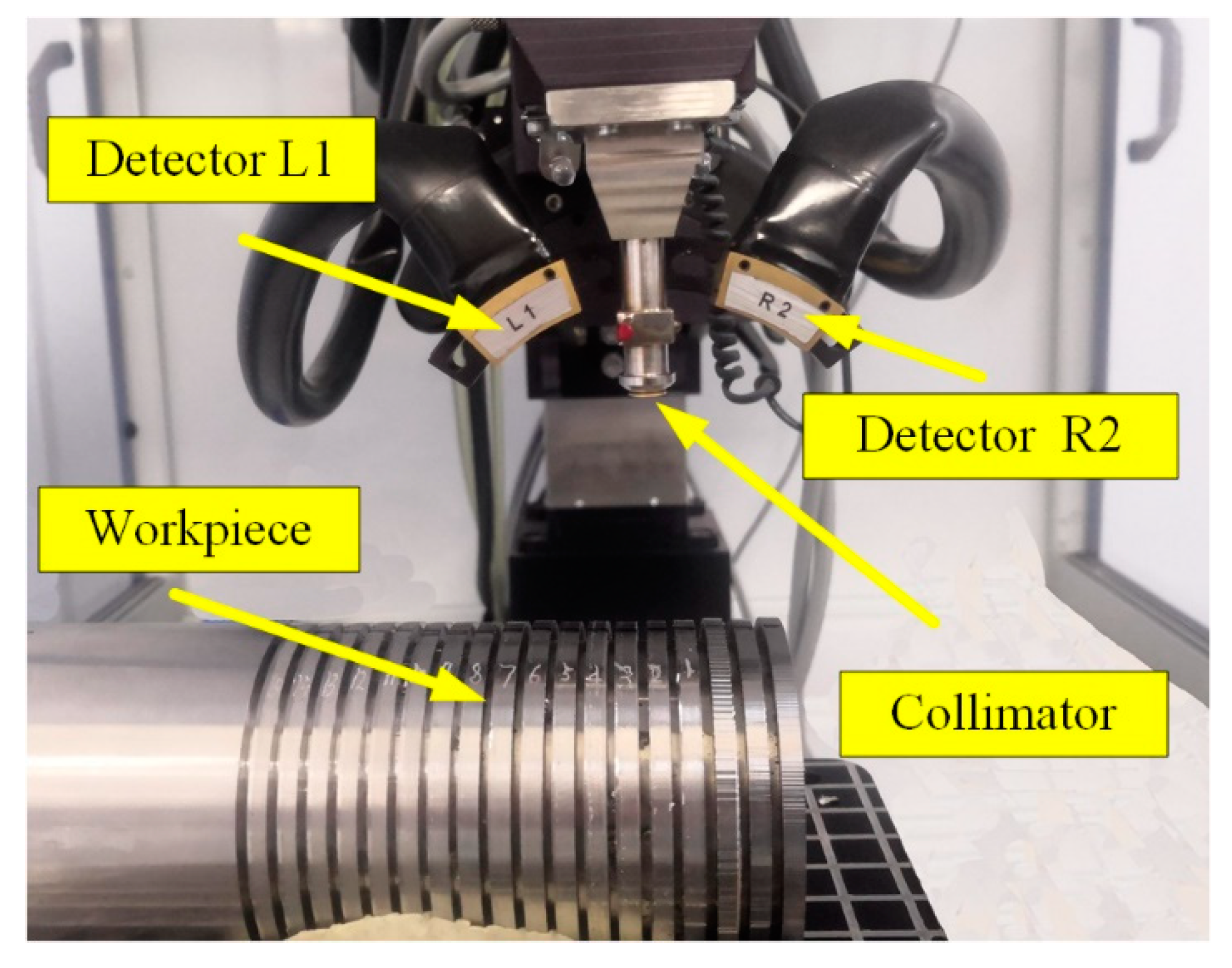
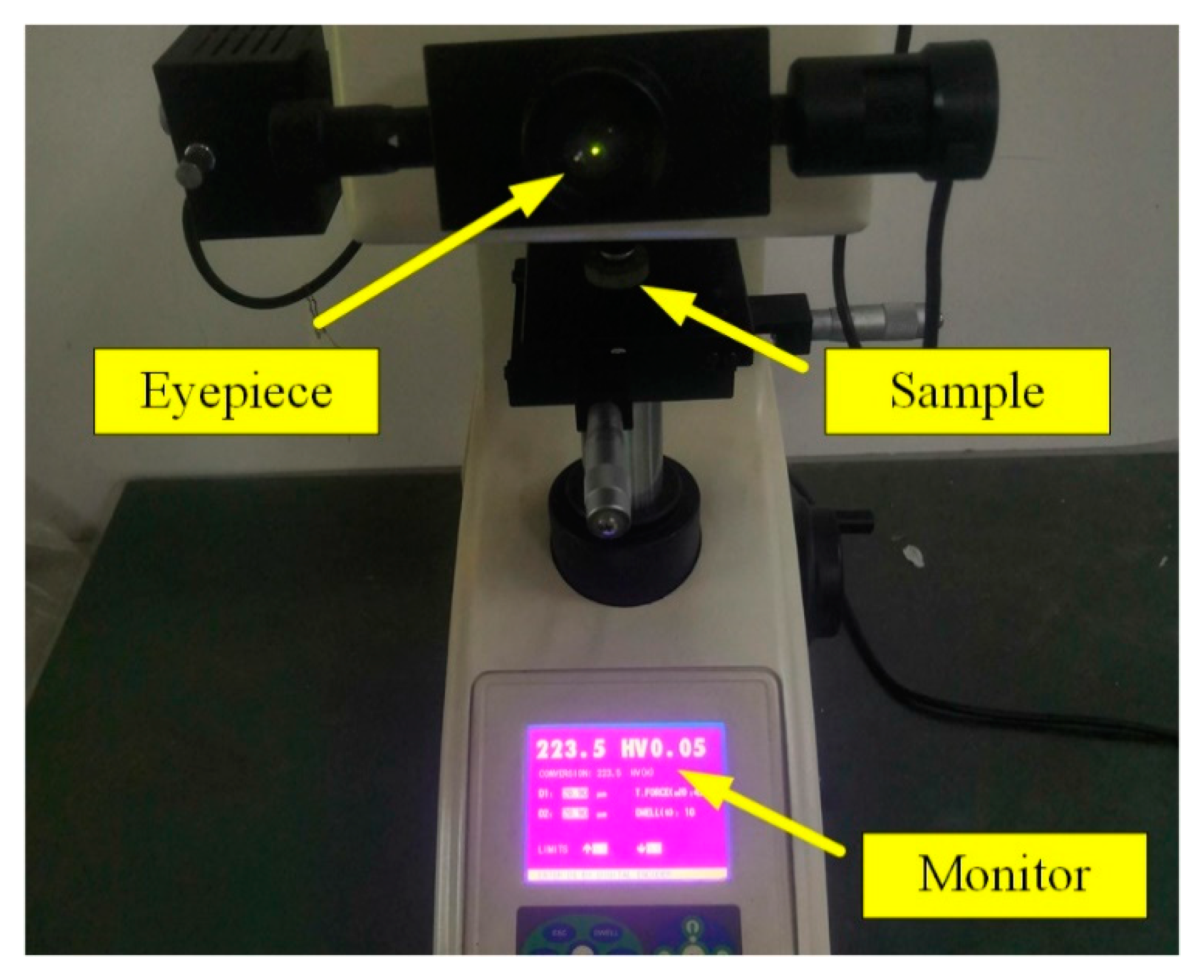
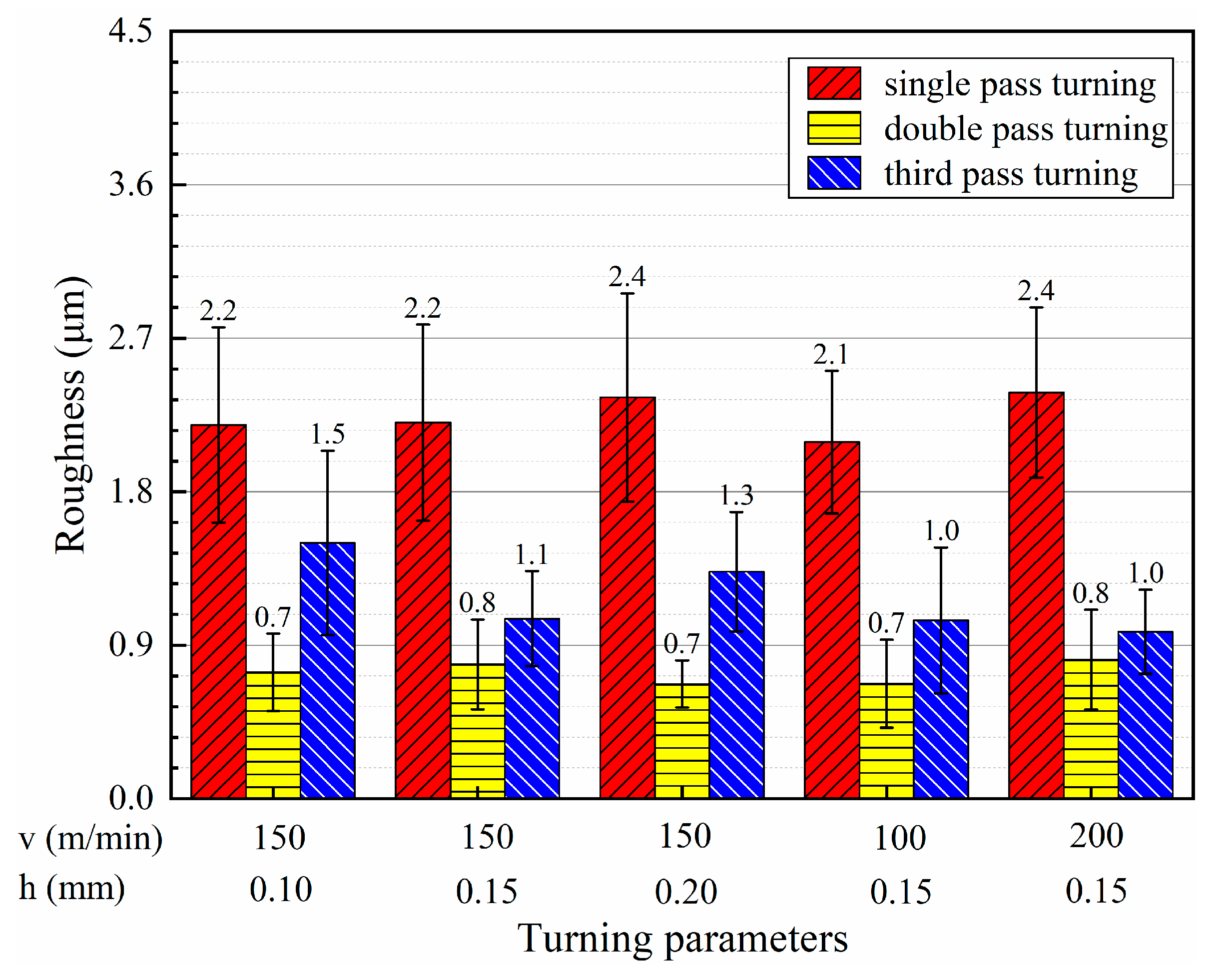
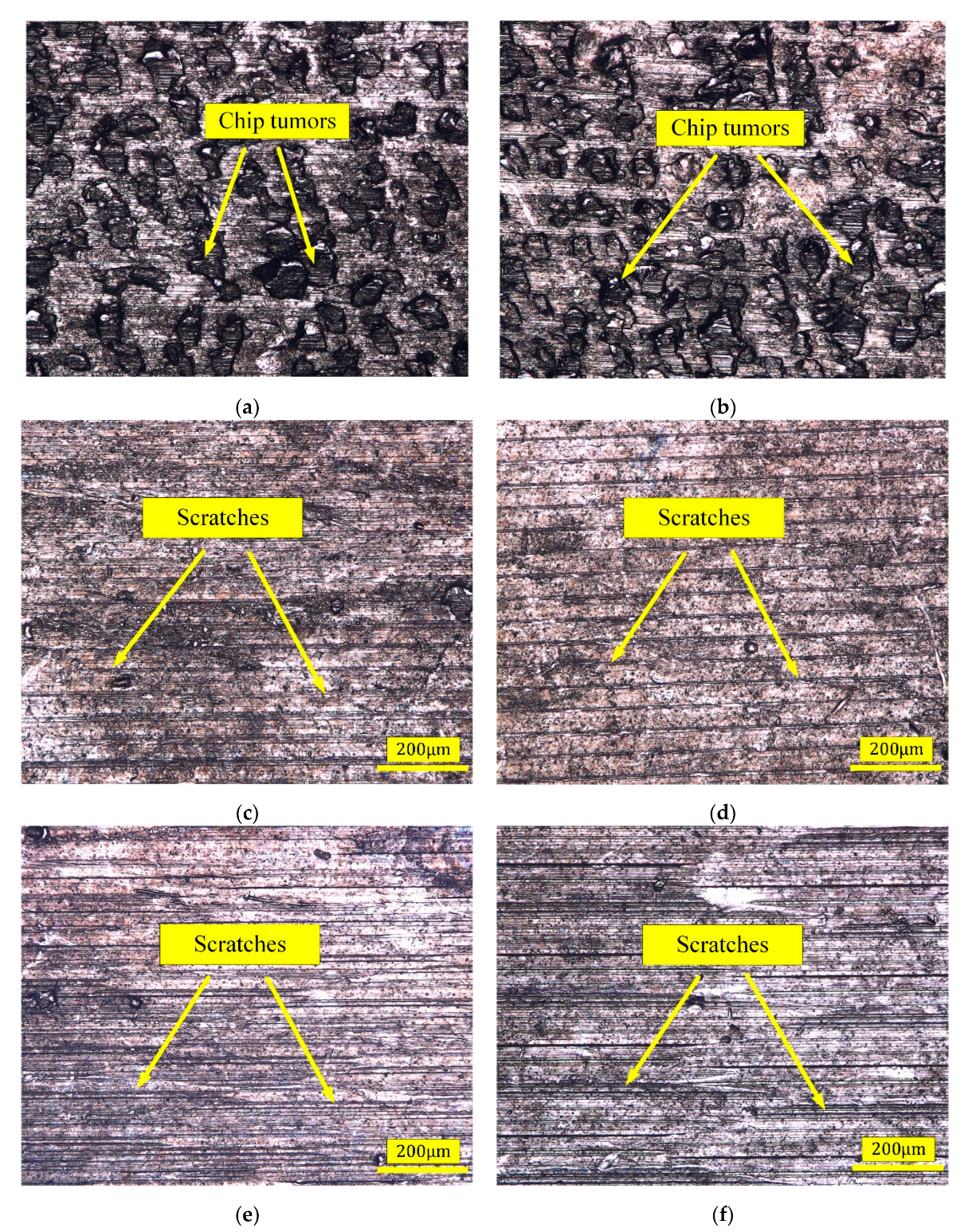
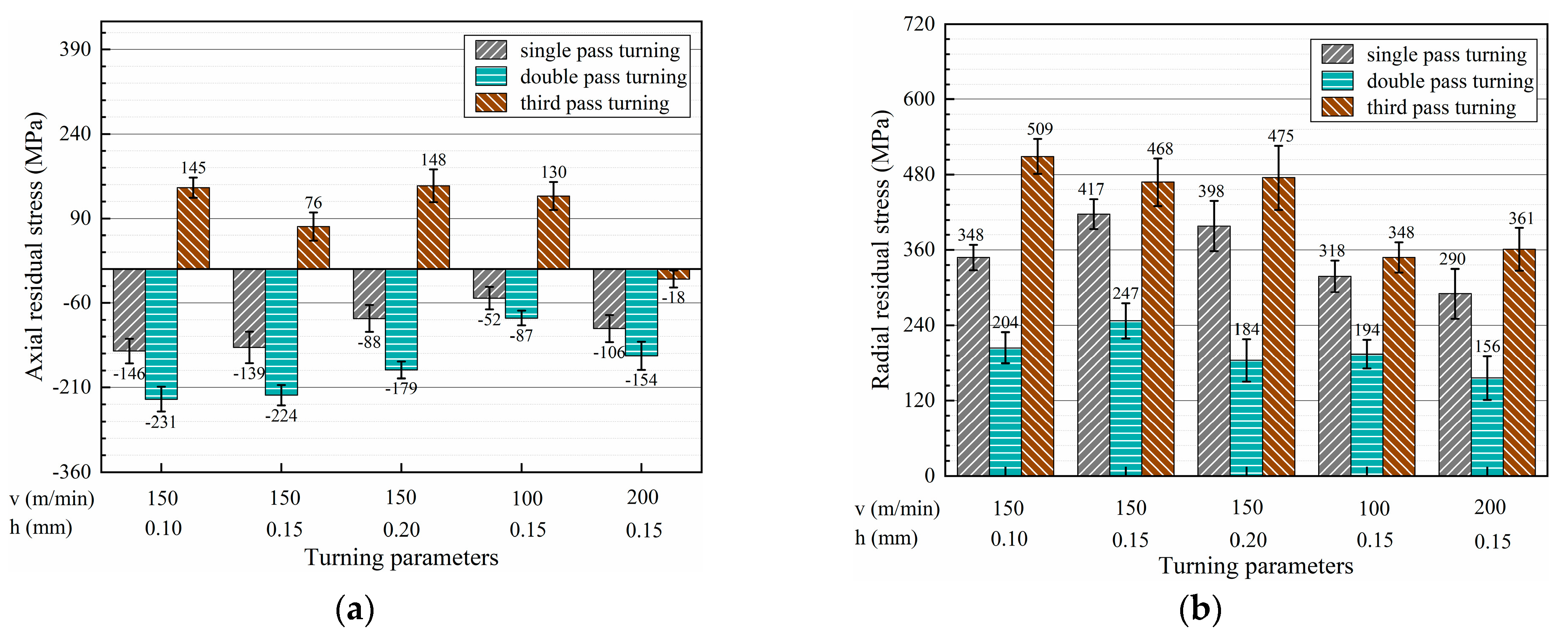


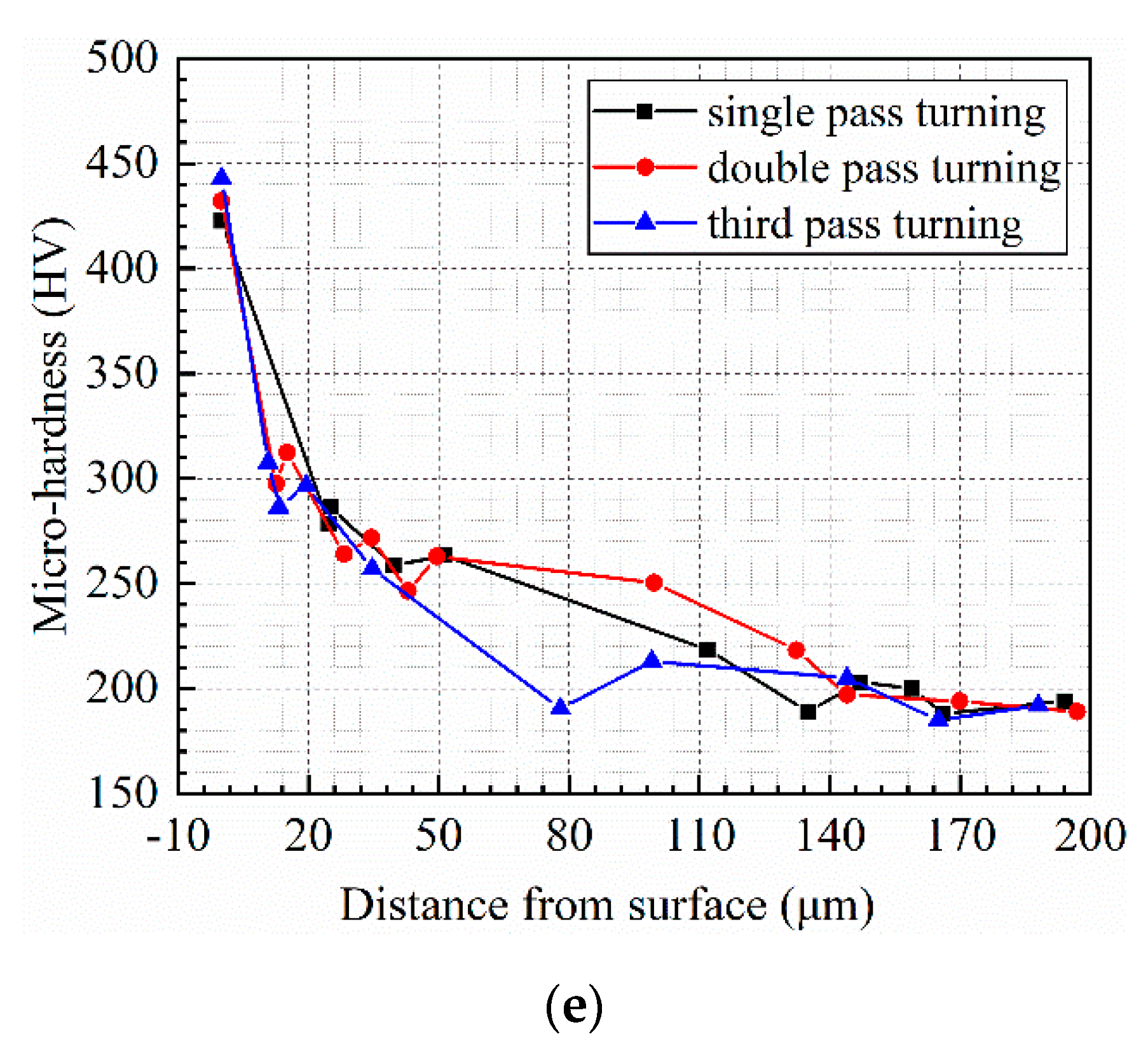



| C | Si | P | Mo | Mn | Cr | Ni | Fe |
|---|---|---|---|---|---|---|---|
| 0.0389 | 0.446 | 0.0225 | 0.172 | 0.675 | 18.3 | 8.53 | Balance |
| Turning No. | Turning Speed v (m/min) | Turning Depth h (mm) | ||
|---|---|---|---|---|
| Single-Pass Turning | Double-Pass Turning | Triple-Pass Turning | ||
| T1 | 150 | 0.10 | - | - |
| T2 | 150 | 0.15 | - | - |
| T3 | 150 | 0.20 | - | - |
| T4 | 100 | 0.15 | - | - |
| T5 | 200 | 0.15 | - | - |
| T6 | 150 | 0.10 | 0.10 | - |
| T7 | 150 | 0.15 | 0.15 | - |
| T8 | 150 | 0.20 | 0.20 | - |
| T9 | 100 | 0.15 | 0.15 | - |
| T10 | 200 | 0.15 | 0.15 | - |
| T11 | 150 | 0.10 | 0.10 | 0.10 |
| T12 | 150 | 0.15 | 0.15 | 0.15 |
| T13 | 150 | 0.20 | 0.20 | 0.20 |
| T14 | 100 | 0.15 | 0.15 | 0.15 |
| T15 | 200 | 0.15 | 0.15 | 0.15 |
| Parameter | Value |
|---|---|
| Radiation | Mn-Kα |
| Collimator type | Round, 2 mm diameter |
| X-ray tube voltage/current | 20 kV/4 mA |
| Ψ angles | 25°, 13.6°, 7.5°, 0°, −7.5°, −13.6°, −25° |
| Bragg angle (2θ) | 156.4° |
| diffraction peak | {3 1 1} |
| Turning Speed (m/min) | Turning Depth (mm) | Density of Cracks (μm/mm2) | ||
|---|---|---|---|---|
| Single-Pass Turning | Double-Pass Turning | Triple-Pass Turning | ||
| 150 | 0.10 | No crack observed | No crack observed | 1861 |
| 150 | 0.15 | 921 | 2072 | |
| 150 | 0.20 | 617 | 5987 | |
| 100 | 0.15 | 1090 | 1223 | |
| 200 | 0.15 | No crack observed | 1965 | |
| Factors | Sum of Squares | Degrees of Freedom | Mean Square | F Ratio | p Value | Remark |
|---|---|---|---|---|---|---|
| v | 0.0289 | 2 | 0.0144 | 1.8571 | 0.2689 | Not significant |
| h | 0.02 | 2 | 0.01 | 1.2875 | 0.3705 | Not significant |
| pass | 4.7937 | 2 | 2.3968 | 308.16 | 0.00004 | Significant |
| h*pass | 0.1582 | 4 | 0.0396 | 5.0857 | 0.0721 | Not significant |
| Error | 0.0311 | 4 | 0.00078 | |||
| Total | 6.3893 | 14 |
| Factors | Sum of Squares | Degrees of Freedom | Mean Square | F Ratio | p Value | Remark |
|---|---|---|---|---|---|---|
| v | 16,636.2 | 2 | 8318.1 | 4.25 | 0.1024 | Not significant |
| h | 4890.9 | 2 | 2445.4 | 1.25 | 0.3787 | Not significant |
| pass | 196,530.4 | 2 | 98,265.2 | 50.22 | 0.0015 | Significant |
| h*pass | 12,632.5 | 4 | 3158.1 | 1.61 | 0.3271 | Not significant |
| Error | 7826.4 | 4 | 1956.6 | |||
| Total | 238,071.3 | 14 |
| Factors | Sum of Squares | Degrees of Freedom | Mean Square | F Ratio | p Value | Remark |
|---|---|---|---|---|---|---|
| v | 20,268.7 | 2 | 10,134.3 | 27.27 | 0.0047 | Significant |
| h | 1186.9 | 2 | 593.4 | 1.6 | 0.3092 | Not significant |
| pass | 136,720.4 | 2 | 68,360.2 | 183.93 | 0.0001 | Significant |
| h*pass | 8803.2 | 4 | 2200.8 | 5.92 | 0.0566 | Not significant |
| Error | 1486.7 | 4 | 371.7 | |||
| Total | 180,436.4 | 14 |
| Factors | Sum of Squares | Degrees of Freedom | Mean Square | F Ratio | p Value | Remark |
|---|---|---|---|---|---|---|
| v | 938.89 | 2 | 469.44 | 30.4 | 0.0038 | Significant |
| h | 2592.89 | 2 | 1296.44 | 83.94 | 0.0005 | Significant |
| pass | 2036.32 | 2 | 1018.16 | 65.92 | 0.0009 | Significant |
| h*pass | 244.09 | 4 | 61.02 | 3.95 | 0.1059 | Not significant |
| Error | 61.78 | 4 | 15.44 | |||
| Total | 5172.4 | 14 |
| Factors | Sum of Squares | Degrees of Freedom | Mean Square | F Ratio | p Value | Remark |
|---|---|---|---|---|---|---|
| v | 182,254.2 | 2 | 91,127.1 | 0.39 | 0.7 | Not significant |
| h | 4,090,754.9 | 2 | 2,045,377.4 | 8.76 | 0.0345 | Significant |
| pass | 23,280,775.0 | 2 | 11,640,387.5 | 49.87 | 0.0015 | Significant |
| h*pass | 9,455,450.4 | 4 | 2,363,862.6 | 10.13 | 0.0228 | Significant |
| Error | 933,651.1 | 4 | 233,412.8 | |||
| Total | 34,866,544.9 | 14 |
| Surface Properties | N | r | Correlated | Remark |
|---|---|---|---|---|
| Roughness | 15 | −0.0059 | Negatively | Extremely weak |
| Micro-hardness | 15 | 0.5080 | Positively | Moderate |
| Axial residual stress | 15 | 0.7526 | Positively | Strong |
| Radial residual stress | 15 | 0.6832 | Positively | Strong |
Publisher’s Note: MDPI stays neutral with regard to jurisdictional claims in published maps and institutional affiliations. |
© 2022 by the authors. Licensee MDPI, Basel, Switzerland. This article is an open access article distributed under the terms and conditions of the Creative Commons Attribution (CC BY) license (https://creativecommons.org/licenses/by/4.0/).
Share and Cite
Zhang, Y.; Xue, H.; Li, Y.; Wang, X.; Jiang, X.; Yang, C.; Fang, K.; Zhang, W.; Jiang, H. Effects of Multi-Pass Turning on Stress Corrosion Cracking of AISI 304 Austenitic Stainless Steel. Micromachines 2022, 13, 1745. https://doi.org/10.3390/mi13101745
Zhang Y, Xue H, Li Y, Wang X, Jiang X, Yang C, Fang K, Zhang W, Jiang H. Effects of Multi-Pass Turning on Stress Corrosion Cracking of AISI 304 Austenitic Stainless Steel. Micromachines. 2022; 13(10):1745. https://doi.org/10.3390/mi13101745
Chicago/Turabian StyleZhang, Yansong, Huan Xue, Yongchun Li, Xuelin Wang, Xinli Jiang, Chongwen Yang, Kewei Fang, Wenqian Zhang, and Hui Jiang. 2022. "Effects of Multi-Pass Turning on Stress Corrosion Cracking of AISI 304 Austenitic Stainless Steel" Micromachines 13, no. 10: 1745. https://doi.org/10.3390/mi13101745
APA StyleZhang, Y., Xue, H., Li, Y., Wang, X., Jiang, X., Yang, C., Fang, K., Zhang, W., & Jiang, H. (2022). Effects of Multi-Pass Turning on Stress Corrosion Cracking of AISI 304 Austenitic Stainless Steel. Micromachines, 13(10), 1745. https://doi.org/10.3390/mi13101745





